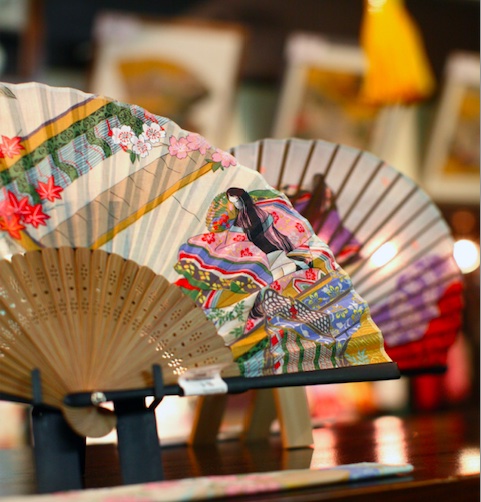‘The Tale of Genji’ is more than 1,000 years old. What explains its lasting appeal?

Perhaps it was the fact that my daughter was in her final year of high school while I was reading “The Tale of Genji,” a 1,300-page tome written more than 1,000 years ago by a lady-in-waiting at the court of a Japanese emperor. But when I reached a pivotal scene, a few lines of poetry nearly undid me.
Hikaru Genji, the titular hero, had asked one of his many wives to give up their daughter to be raised at court by another woman. As the little girl’s mother, Lady Akashi, watched the toddler climb into a carriage waiting to spirit her away, she recited a classical waka poem:
Its future lies in the far off distance
This pine seedling being taken from me
When will I see it spread its splendid shade
“Shedding tears,” I read, “she could say no more.”
In those lines, I foresaw my own grief. Soon I would be saying goodbye to a daughter, too, when we would leave her at a university thousands of miles away.
I had picked up “Genji Monogatari,” as it is known in Japanese, out of professional interest. As the Tokyo bureau chief for The New York Times, it felt like a gap in my knowledge never to have read the work by Murasaki Shikibu that is often described as the world’s first novel and a touchstone of Japanese literary history.
In Japan, “The Tale of Genji” has maintained an unwavering grip on the culture. Passages are taught to most schoolchildren. It has been subjected to countless translations, interpretations and adaptations across seemingly every possible art form: paintings, Noh plays, dance, film, television drama, manga, anime, even a rom-com.
When I first opened its pages, I was reading for edification. I expected to feel distance from the medieval text. After all, the book is set among the courtly elites of the classical Heian period of the 11th century, with their mysterious rituals, monarchal codes and allusive poetry.
Instead, I found common ground not only with my personal experience but with my reporting over six years as a correspondent in Japan. The more I read, the more this ancient work made me think about how gender and power dynamics have echoed across the centuries in Japan.
The narrative is structured around the life of Genji, who is the son of an emperor and his favorite consort. From the time Genji is barely a teenager, he cavorts across the region now known as Kyoto, hopping from one woman to another as he breezes through affairs and takes on multiple wives. Although he amasses great influence, he never ascends the throne to the pinnacle of power.
There are epic plot twists. Genji has to conceal the paternity of one of his sons, because the boy is the product of Genji’s affair with one of his father’s consorts. (The secret weighs heavily when that boy goes on to become emperor.) One of Genji’s consorts transforms into a jealous spirit who takes possession of one of his other wives, in a spine-chilling scene that prefigures the horror genre. Genji is sent into exile on a remote island after he has sex with a consort of the emperor.
Through it all, the author (a woman! writing more than 1,000 years ago!) continuously centers female perspectives in a work that ostensibly chronicles the escapades of a male hero.
From its opening line, “The Tale of Genji” signals its author’s focus on how women steer the fate of the hero. We are introduced to Genji’s mother, “a woman of rather undistinguished lineage” who has “captured the heart of the emperor and enjoyed his favor above all the other imperial wives and concubines.”
While she may have the emperor’s heart, she is “despised and reviled” by the emperor’s other wives, most prominently the mother of the crown prince and heir to the throne. When Genji is born, “a pure radiant gem like nothing of this world,” he immediately unsettles the political order of the court.
The importance of imperial mothers in “The Tale of Genji” is striking, given that in the current era, women are treated as a side note in the fortunes of Japan’s royal family, the world’s oldest continuous monarchy. The current emperor follows modern mores and has just one wife — imperial concubines were banned in the 20th century — but women who are born princesses must leave the family and renounce their royal titles when they marry. That leaves precious few women to give birth to legitimate heirs. Women themselves are not allowed to rule on the throne.
In “The Tale of Genji,” royal succession was a political power struggle. Now, it is an existential one: There is just one boy in the imperial family’s youngest generation.
Despite periodic debates about allowing women to sit on the throne or even to remain in the family to head legitimate lines of succession, conservative wings in Japan’s governing party oppose such proposals. The Japanese public, on the other hand, overwhelmingly supports changes to the royal laws, not only as a way to save the imperial family from extinction but as a symbol of women’s equality.
Efforts to advance women’s rights in Japan, and the conservative impulse to repress them, were on my mind as I read — often with horror — the scenes of Genji and other men barging into women’s bedrooms. It was hard not to share the interpretation of Jakucho Setouchi, a Buddhist monk who translated a best-selling Japanese edition of “The Tale of Genji” in the late 1990s and characterized most of the sex scenes in the novel as rape.
How else to regard a scene like one where Genji assaults a woman during a party to celebrate the empress (one of his favorite lovers) and the crown prince (his illegitimate son)?
“‘It won’t do you a bit of good to call for someone,” he assured her, ‘since everybody yields to me. So do be quiet.’”
The way so many of the women in the novel respond to their male pursuers eerily evoked what women have told me in interviews about sexual harassment or coercion today.
In the party scene, the young woman is frightened of Genji when he pursues her in a hallway. But she does little to resist because she “didn’t want to come off looking cold or stiff.” Even now, women tell me, they fear causing offense — not only to the men who prey upon them, but to their friends and family or those on social media who might criticize them.
How distressingly familiar, then, was a chapter where one of Genji’s sons, Yugiri, pursues a princess and presumes she should yield to him, simply because he spies a glimpse of her through the doors of her bedroom. Even the fact that she answers a poem he slips to her — with a polite demurral, no less — bolsters his sense of sexual entitlement.
When the princess’ mother learns that he is vexed by her rejection, she chastises her daughter. “It was careless of her to keep only a sliding panel between them, and it’s an absolute disgrace that she allowed him to see her so easily,” the mother rants to an attendant.
Yet reading the Genji as a “rape narrative” is, of course, anachronistic. The men in the novel are just behaving as would have been expected in the polygamous court culture of the time. A #MeToo reading may also foreclose the possibility of understanding the love that blooms between Genji and many of his partners. “It’s OK to have a democratic reading of Genji, to bring your own biases and world to it,” said Melissa McCormick, professor of Japanese art and culture at Harvard University, “and to have the opportunity to get a glimmer of something else while you are doing it.”
Even the relationship that in some ways is most difficult to stomach, that between Genji and Lady Murasaki, a girl he begins to groom as his partner when she is just 10 years old, grows into a marriage of spiritual compatibility. In his own, polyamorous way, Genji remains staunchly loyal to her until her death.
Saeko Kimura, a professor of Japanese literature at Tsuda University, a women’s college in Tokyo, told me that when students express distaste for Genji’s serial seductions, she advises them to think of him as an “oshi” — a favorite pop idol or actor.
It’s not an inapt comparison. The notion of masculinity represented by Genji is recognizable in modern day Japan. Unlike in European epics, Genji “was not described as a man of muscle, capable of lifting a boulder that not ten men could lift, or as a warrior who could single-handedly slay masses of the enemy,” the literary scholar Donald Keene wrote in “Chronicles of My Life: An American in the Heart of Japan.”
Repeated references to Genji as “the Radiant Prince,” a man who “was so beautiful that pairing him with the very finest of the ladies at the court would fail to do him justice” and who “was like the flowering tree under whose shade even the rude mountain peasant delights to rest,” made me think at times of so-called “genderless danshi,” young men who blur the lines between masculine and feminine aesthetics and fashion. In Genji’s beauty, I could well imagine the main character of an anime or the lead singer in a J-pop band.
Ultimately, what made the story so powerful for me was the way Murasaki conveyed the women’s thoughts and feelings. At the time of her writing, many of her readers would have been women. Yet according to literary historians, prominent men of the court also read the tale contemporaneously. In that light, the way she foregrounded women’s emotions — their fear, suffering, disappointment, envy and anxieties — seems almost subversive.
Even today, when women in Japan still lack power in politics and business, they are an important force in fiction, with writers like Mieko Kawakami, Sayaka Murata, Yoko Ogawa and Yu Miri winning Japan’s top literary prizes and representing the vanguard of modern Japanese literature in translation. They write about how their characters confront punishing beauty standards, expectations that they become mothers, ambition (or lack thereof) and sexual assault, all topics that women may be publicly shamed for talking about in other forums.
In her own writing, Murasaki winked at the potency of fiction. When Genji flirts with a woman who he has told others is his long-lost daughter (when, in fact, she is the daughter of his best friend and sometimes rival — yes, it’s as awkward as it sounds) he teases her for reading so many romantic stories.
“You know full well these tales have only the slightest connection to reality, and yet you let your heart be moved by trivial words and get so caught up in the plots that you copy them out without giving a thought to the tangled mess your hair has become in this humid weather,” Genji tells the young woman, Tamakazura.
After Genji describes the tales as no more than “spinning lies,” Tamakazura delivers a snappy clapback.
“There is certainly no doubt that someone practiced at lying would be inclined to draw such a conclusion … for all sorts of reasons,” she says to Genji. “I remain convinced, however, that these stories are quite truthful.”
Eager to extend the flirtatious exchange, Genji concedes that storytelling conveys “things of this world” and that “the narrow-minded conclusion that all tales are falsehoods misses the heart of the matter.”
With the endurance of “The Tale of Genji,” it’s hard not to think that in life, as well as in fiction, a woman has gotten the final word.
This article originally appeared in The New York Times.






